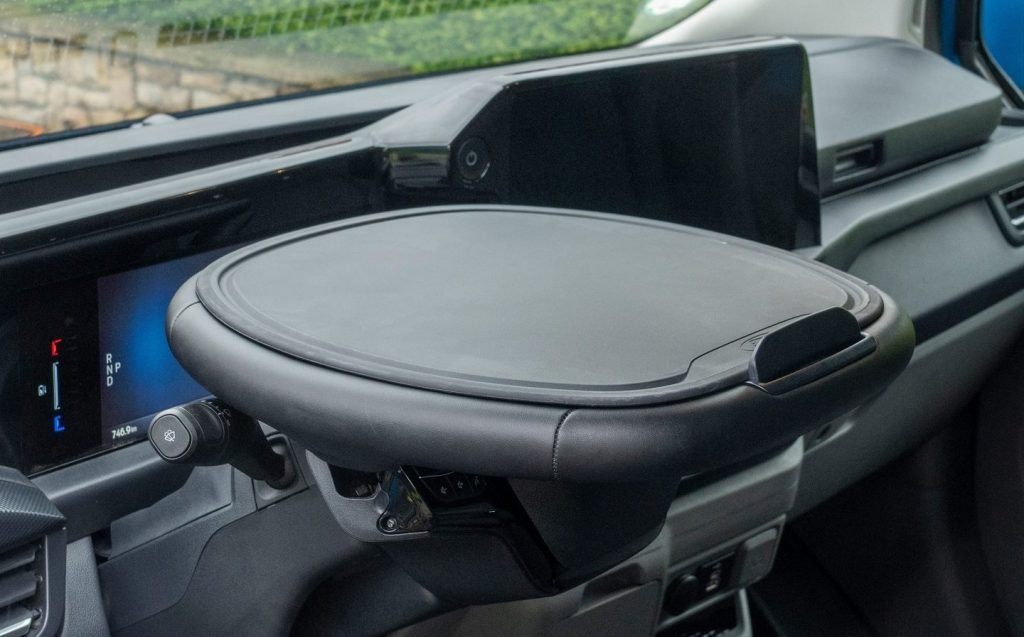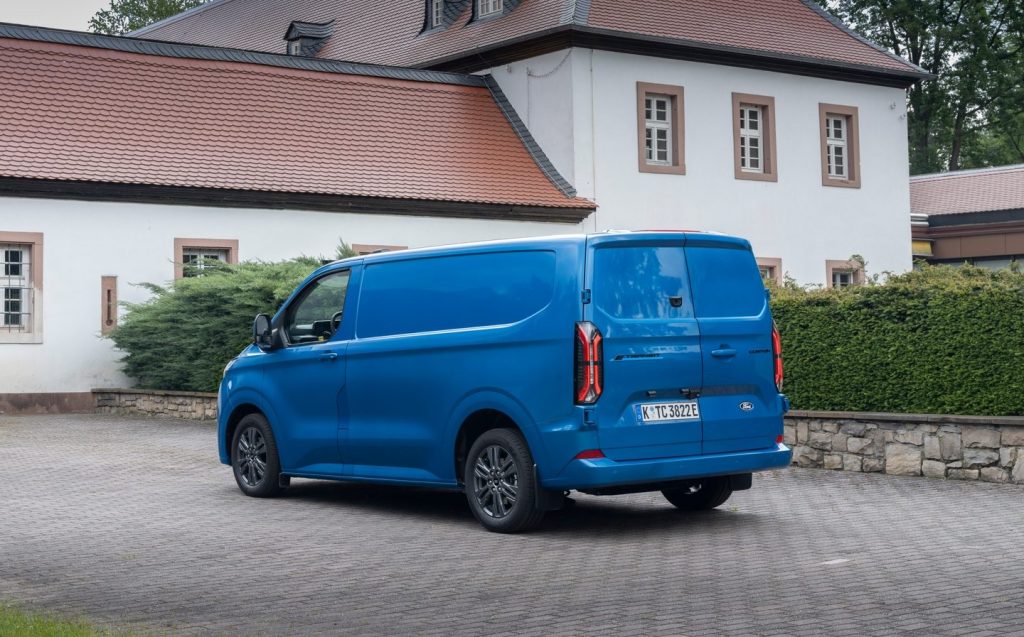Ford e-Transit Custom 2024 review: The backbone of Britain goes electric
There’s even a sporty MS-RT version
What do you think was the best-selling vehicle in the UK in 2023? The Tesla Model Y? Vauxhall Corsa? Nissan Qashqai? Ford Puma? No, no, no and no again. It was, in fact, the Ford Transit, the commercial vehicle once tagged the “Backbone of Britain”.
Actually, that is a little misleading, because while you might hear the word “Transit” and imagine, from your historical understanding of the nameplate, one van that can be configured any which way but loose (different wheelbases, body styles, roof heights and so on), these days Ford sells four distinct product lines under the overarching Transit banner.
There are the smaller Transit Courier and Transit Connect models; the plain old Transit, which is the daddy and very large vehicle these days; then there’s this Transit Custom — probably about the size van you’d be thinking of if you remember the classic Transits of the 1970s and ’80s.

So, while the two bigger lines racked up a huge 69,145 units between them, that number was split between the Custom (first in the commercial vehicle chart) and the Transit (second in the overall list for 2023).
Still, that means the Transit Custom alone was a bigger seller than the Vauxhall Corsa (the third best-selling car in the UK last year), the van only eclipsed in popularity by the sales juggernauts that are the Qashqai and Puma.

And one day, Ford’s trusty van might even take the Model Y’s crown as the best-selling electric vehicle (EV) in the UK, because the Transit Custom you’re looking at here is pure-electric, and is therefore one of the most important model launches this year in the wider automotive world.
This electric van is a new addition to a family that already offers turbodiesel and plug-in hybrid powertrains and supports Ford’s ambition to electrify all of its product ranges — including its commercials — in short order.
The larger Transit has already gained an electric version so it makes sense that Ford would port the same zero-emissions technology into the more compact Transit Custom.

The giveaway that it’s the electric model is badging you can see on the rear doors, which reads “e-Transit Custom”. Aside from that, only a front-mounted charging port under its headlight and a lack of exhaust outlet at the back differentiates it from your common-or-garden diesel Transit Custom.
This visual similarity is designed to persuade the usual customers of Ford’s mid-sized van into taking a punt on the electric version. It’s supposed to look as familiar as possible so that small- and medium-sized business enterprises (SMEs) start replacing their diesel fleets with these ultra-clean electric alternatives sooner, rather than later.
In as much as it is possible to make the simplistic shape of a van look good, Ford’s stylists should be commended. The E-Transit Custom is a handsome contrivance, as every electric model has LED front lamps with a full-width light strip for good measure.

It’s made even easier on the eye in Sport specification, with its twin bonnet stripes, rear spoiler and 17in alloys, but some might find the extreme model above this one a bit too much, in terms of commercial vehicles.
Called the MS-RT, for M-Sport Road Technology — M-Sport being the outfit which preps Ford’s World Rally Championship (WRC) cars — it’s a bonkers-looking device with a super-aggressive appearance, courtesy of meatier lower bodywork and bumpers, 19in multi-spoke alloys and a lovably daft split twin-spoiler on top of its rear doors. You can also have it in some searing colours, such as Yellow Green, if you wish.

That MS-RT is powered by a potent 210kW (281bhp) motor, but for most commercial users either the 160kW (214bhp) or the base 100kW (134bhp) options will serve just fine.
All E-Transit Customs, no matter their power output, produce the same maximum 306lb ft of torque (twisting force from the motor), while they are all also equipped with one battery pack size, which has 64kWh of usable energy.
That leads to official range figures of between 171 and 209 miles, which are decent enough for a commercial like this that might only be used for urban and semi-urban delivery routes, though range depends greatly on a number of factors, including speeds, ambient temperatures (cold is not an EV’s friend) and payload.
Going with the official figures, though, there are other electric vans in the same class with greater range than the Transit Custom, which might put some customers off the Ford.

Another issue is that the E-Transit Custom is quite a lot more expensive than a plain old turbodiesel one. While the Transit Custom starts from £32,350 excluding VAT, the cheapest E-Transit Custom is £43,380 excluding VAT, and prices go up to the wrong side of 60 grand for the madcap MS-RT.
Of course, this should be offset against potential savings. If charging from the mains, fuel costs will be reduced, and all E-Transit Custom models have the various tax benefits associated with EVs, so fleet managers will need to do their sums. Still, it’s still a lot of additional outlay to have to recoup across the longer-term operation of a small fleet.
Nevertheless, for all this price- and range-related carping, there’s little doubt the E-Transit Custom is an absolutely excellent commercial vehicle, electric or otherwise.
Maximum payload in the electric van is up to 1,011kg, although bear in mind many models have to be rated at less than a tonne to ensure they don’t exceed the allotted gross vehicle weight for vans in this category.

But, thanks to mounting the electric motor under the van’s floor at the back — yes, every E-Transit Custom is rear-wheel drive — there’s no sacrificing of the Ford’s load-bay dimensions, which means more than 2.6 metres in bed length from the doors to the bulkhead behind the cab; a through-load system into the front can even accommodate items 3,050mm long.
The cargo area measures 1,777mm at its widest and 1,392mm between the wheel arches, and it is 1,433mm high. All this amounts to a chunky 5.8 cubic metres of load space and that’s just with the standard wheelbase.
Those looking to tow a trailer behind their commercial also won’t be disappointed, as the Ford electric van can haul 2,300kg of braked trailer – which is more than the plug-in hybrid (2,000kg), albeit slightly less than the turbodiesel (2,500kg).
Perhaps even more impressive than all its business-related credentials, though, is the sheer quality of the E-Transit Custom. This counts for both its well-appointed and high-tech cab and the refined manner in which it drives.

Every model gains the 13in SYNC 4 infotainment touchscreen in the middle of the dash, as well as an 8in configurable digital instrument cluster. OK, so there are no separate climate control switches any longer — all of the heating and cooling of the cab takes place via the screen — but in general this system works well, and it looks as modern as anything you’d find in one of Ford’s top-end cars these days.
Storage solutions are useful throughout the cab as well, although perhaps the E-Transit Custom’s party piece is the fold-down steering wheel, which can double as a table or tray for the driver once a central piece of plastic is clipped into the horizontal rim of the wheel itself.

It’s only operable when the vehicle is in Park on the gearbox, with the selector column-mounted, so there’s no danger of the wheel flipping down while you’re in motion.
Once you’ve acclimatised to the car-like interior, you’ll then be treated to a superb, car-like driving experience to go with it.
Make no mistake, the E-Transit Custom has lost nothing by transitioning from diesel or plug-in hybrid power to a drivetrain with no internal combustion component whatsoever.
If anything, the smooth and cultured power delivery of an electric system only suits this commercial even better, because it has ride and handling characteristics that are not van-like at all.

Sitting up high in a luxurious cab, with great visibility afforded by the glasshouse and a clear rear-view camera system serving as an interior mirror, when you’re driving something as comfortable, quiet and refined as the e-Transit Custom, it is in many ways even more enjoyable to pilot than most cars are these days.
Perhaps Ford could have eked out more range from the battery pack, just to give the E-Transit Custom a broader appeal to businesses which have longer-distance use cases. But, on the flipside, the commercial vehicle maker had to keep in mind payloads and practicality, and there’s always a Transit Custom EcoBlue diesel or plug-in hybrid to satisfy those kinds of customers.
As it is, some of the ancillaries surrounding the E-Transit Custom make it even more desirable to SMEs. Such as the optional Pro Power Onboard feature, which puts a domestic socket in the back of the van so tradespeople can operate power tools, even when they’re a long way from the domestic grid.
It’s said that running a circular saw off this system will only sap three miles of range from the battery pack for every hour of usage, which is less than what the air conditioning will slice off the remaining range if you crank it up in the cab.

Then there’s the new home-charging solution Ford Pro has introduced, as well as Ford Pro Telematics, an online app which allows SME logistics managers to oversee and maintain their vehicle fleets precisely at all times.
Speaking of charging, the E-Transit Custom has a maximum charging rate of 125kW on DC, which means it’ll go from 10-80 per cent battery charge in just 39 minutes at its fastest. On a standard 7.4kW wallbox, it’ll take more like ten hours to fully replenish the charge, but if vans are left unused overnight, they may as well be plugged in and slow-charged.

All of which adds up to a brilliant commercial vehicle. Yes, the Ford E-Transit Custom is not cheap, and it also doesn’t have the driving range of some electric rivals, never mind traditional vans powered by diesel engines.
But if its medium-range proposition works for your business, and you work out that the low running costs could add up to log-term savings, it ought to be the first thing you’re looking at for your fleet needs.
And in not many years’ time, it’s possible that of all those tens of thousands of Ford Transit Customs hitting the UK’s roads each year, the majority of them will be zero-emission E-Transit Custom models.
Related articles
- If you found our review of the electric Ford E-Transit Custom interesting, you might like to read about Kia’s plans to launch a range of electric commercial vehicles
- Want to know what the best-selling cars in the UK are?
- And make sure you read our Ford E-Transit review too
Latest articles
- Skoda Enyaq 2025 review: Same book, different cover for electric SUV
- Lewis Hamilton wants to design a modern day Ferrari F40 with manual gearbox
- Dacia Bigster 2025 review: The ‘anti-premium’ family SUV that punches above its weight
- Your car’s worn tyres could be being burnt illegally in India, investigation reveals
- Open-top 214mph Aston Martin Vanquish Volante is world’s fastest blow-dry
- F1 2025 calendar and race reports: The new Formula One season as it happens
- Alfa Romeo Junior Ibrida 2025 review: Hybrid power adds an extra string to crossover’s bow
- Top 10 longest-range electric cars: all with over 400 miles per charge (officially)
- Renault 5 Turbo 3E ‘mini supercar’ confirmed with rear in-wheel motors producing 533bhp … and insane levels of torque

































